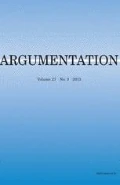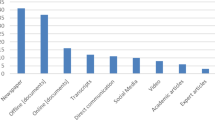Abstract
“Place” as an argumentative domain, which has been taken for granted and treated by theorists of argumentation simply as a physical notion designating the occasion where an argumentation takes place, carries far more complex meanings beyond its traditionally assumed domain in the following three dimensions: as a geographical locale; as a concept, an idea, a history or a notion with its own disputable narratives and presumptions; and as an imaginative geography. Similarly, an image or a character projected through argumentative discourse should be among the central concerns for argumentation studies, however, limited attention has nevertheless been paid to this traditional face of argument in general and the collective face in particular. We argue that image is a site of discursive production, a symbolic field or a discursively disputable space. The discursive interplay among “place,” “image,” “argument” and “time” offer a new way of thinking about ethotic argument and its key role in the establishment of discursive credibility.
Similar content being viewed by others
Notes
In the decade-long debate, the point of stasis is about abandoning the term “dragon” and adopting the new one “loong” originating from Chinese pinyin. The protagonists’ argument is that in view of the extremely negative connotations of the word “dragon” in the Bible, it should therefore be discarded, whilst the antagonists’ argument is that as a long-in-circulation term, “dragon” is already in the discursive system dominated by the West and can hardly be substituted with a new term. For further information, please visit these two websites: http://www.loong.cn/default.htm; http://www.loongfeng.org/.
For further information, please refer to this website: https://www.pc.gc.ca/en/lhn-nhs/on/malden.
As Mao (2006) rightly observes, there are two discursive axioms deeply entrenched in the Chinese argumentative discourse: that of “suffering mightily to gain” [si yao mianzi huo shouzui/死要面子活受罪] which “vividly identifies the danger of pursuing [face] at any cost” and implies that “the amount of [face] one gains loses its value” and “whatever one gains is tainted with negative connotations, with vanity and shallowness”; that of “beating one’s face swollen so that it makes one look big [da lian chong pangzi/打脸充胖子]” which metaphorically means “to mock at those individuals who would pay any price to gain face [yao lian/要脸]” (p. 156). In Chinese argumentative practice, the discursive principle of “not losing one’s face” [bu diu lian/不丢脸] is juxtaposed with those of “losing one’s face,” “not wanting one’s face,” and “not gaining face” [bu yao lian/不要脸]. These principles are morally and ethically humiliating and discursively counterproductive since they have the implication that a person who does not care about losing his or her face in a public space may probably turn out to be an opportunist who tends to gain what he or she wants at any price. Similarly, as Erving Goffman rightly observed in the 1950s, people “caught out in the act of telling barefaced lies” risked the danger of “losing face during the interaction” and “having their face destroyed” (1956: 40).
Pinyin refers to the spelling and pronunciation system practiced on mainland China. In order to differentiate the pronunciation of pinyin [lóng] from the English adjective long, there came the neologism “loong,” of which Joshua Marshman, a British missionary, was its first user in his Elements of Chinese Grammar published in 1814. Since, one common practice for Western missionaries to translate [龍/龙] into English was to juxtapose them in the order of “龍, loong, a dragon.” (http://www.sohu.com/a/205160738_657353).
“Xi: We call ourselves descendants of the dragon.” (https://www.youtube.com/watch?v=J0fABpNxLLc).
With references to this website: https://rarehistoricalphotos.com/warschauer-kniefall-1970/.
Gee (2011) differentiates two kinds of discourses, i.e. Discourse with an uppercase “D” and discourse with a lowercase “d.” The former refers to “ways of combining and integrating language, actions, interactions, ways of thinking, believing, valuing, and using various symbols, tools, and objects to enact a particular sort of socially recognizable identity” (pp. 29, 201), while the latter designates “any instance of language-in-use or any stretch of spoken or written language (often called a ‘text’ in the expanded sense where texts can be oral or written)” (p. 205).
For example, in his first interview with domestic media on May 21, 2019 after the U.S. placed the company and its affiliates on the “Entity List,” a photo of a bullet-ridden aircraft became a topic of the first question. Mr. Ren thought the very image of the badly damaged fighter aircraft was similar to the situation facing his company. Out of this consideration, a placard of this photo with the caption (“Heroes in any times go through great challenges.”) was made into a placard as a piece of visual communication among Huawei staff to encourage them to face up to the cruel reality. Source: http://en.people.cn/n3/2019/0523/c90000-9581056.html.
References
Aristotle. 2007. On rhetoric: A theory of civic discourse. Trans. George A. Kennedy. 2nd ed. New York: Oxford University Press.
Arendt, Hannah. 2003. Responsibility and judgment. Edited and with an Introduction by Jerome Kohn. New York: Schocken Books.
Barthes, Roland. 1977. Rhetoric of the image. In Image, music, text. Edited and translated by Stephen Heath. New York: Hill and Wang.
Bitzer, Lloyd. 1968. The rhetorical situation. Philosophy and Rhetoric 1(1): 1–14.
Booth, Wayne C. 1961. The rhetoric of fiction. Chicago and London: The University of Chicago Press.
Booth, Wayne C. 1974. Modern dogma and the rhetoric of assent. Chicago: The University of Chicago Press.
Booth, Wayne C. 1988. The vocation of a teacher: Rhetorical occasions 1967–1988. Chicago: The University of Chicago Press.
Bloom, Harold. 2003. A map of misreading. Oxford: Oxford University Press.
Brinton, Alan. 1986. Ethotic argument. History of Philosophy Quarterly 3(3): 245–258.
Burke, Kenneth. 1966. Language as symbolic action: Essays on life, literature, and method. Berkeley: University of California Press.
Burke, Kenneth. 1969. A rhetoric of motives. Berkeley: University of California Press.
Confucius. 2003. Analects: With selections from traditional commentaries. Trans. Edward Slingerland. Indianapolis: Hackett Publishing Company.
Crosswhite, James. 1996. The rhetoric of reason: Writing and the attractions of argument. Madison: The University of Wisconsin Press.
Gee, James Paul. 2011. An introduction to discourse analysis: Theory and method. 3rd ed. New York: Routledge.
Goffman, Erving. 1955. On face-work: An analysis of ritual elements in social interaction. Psychiatry 18(3): 213–231.
Goffman, Erving. 1956. The presentation of self in everyday life. Edinburgh: University of Edinburgh.
Hu, Hsien Chin. 1944. The Chinese concepts of “face”. American Anthropologist 46(1): 45–64.
Liu, Yameng. 2004. In pursuit of symbolic power [zhuiqiu xiangzheng de liliang/追求象征的力量]. Beijing: SDX Publishing House.
Mao, LuMing R. 1994. Beyond politeness theory: ‘Face’ revisited and renewed. Journal of Pragmatics 21: 451–486.
Mao, LuMing. 2006. Reading Chinese fortune cookie: The making of Chinese American rhetoric. Logan: Utah University Press.
Perelman, Chaim, and L. Olbrechts-Tyteca. 1969. The new rhetoric: A treatise on argumentation. Notre Dame: University of Notre Dame Press.
Qi, Xiaoying. 2011. Face: A Chinese concept in a global sociology. Journal of Sociology 47(3): 279–295.
Said, Edward. 2006. Invention, memory and place. Critical Inquiry 26: 175–192.
Taylor, Charles. 1989. Sources of the self: The making of the modern identity. Cambridge: Harvard University Press.
Tindale, Christopher W. 1999. Acts of arguing: A rhetorical model of argumentation. Albany: State University of New York Press.
Tindale, Christopher W. 2004. Rhetorical argumentation: Principles of theory and practice. Thousand Oaks: Sage Publications.
Tindale, Christopher W. 2015. The philosophy of argument and audience reception. Cambridge: Cambridge University Press.
Trudeau, Justin. 2000. Justin Trudeau’s eulogy to his father. The Globe and Mail. Oct. 4. https://beta.theglobeandmail.com/news/politics/jetaimepapa-justin-trudeaus-2000-eulogy/article26923529/.
van Eemeren, Frans H. 2019. Argumentative style: A complex notion. Argumentation 33(2): 153–171.
Walton, Douglas N. 1996. Arguments from ignorance. University Park: Pennsylvania State University Press.
Wei, Yong-kang. 2002. Corporate image as collective ethos: A poststructuralist approach. Corporate Communications: An International Journal 7(4): 269–276.
Acknowledgements
Professor Christopher W. Tindale has been the de facto co-agent of this project. I’ve benefited enormously from many of our discussions in the writing process. Therefore, I would like to extend my sincerest gratitude to him for his valuable comments and suggestions. I am also very grateful to a reviewer whose sharp criticism and comments have also been helpful in various ways.
Author information
Authors and Affiliations
Corresponding author
Additional information
Publisher's Note
Springer Nature remains neutral with regard to jurisdictional claims in published maps and institutional affiliations.
Rights and permissions
About this article
Cite this article
Wang, J. Place, Image and Argument: The Physical and Nonphysical Dimensions of a Collective Ethos. Argumentation 34, 83–99 (2020). https://doi.org/10.1007/s10503-019-09488-w
Published:
Issue Date:
DOI: https://doi.org/10.1007/s10503-019-09488-w




